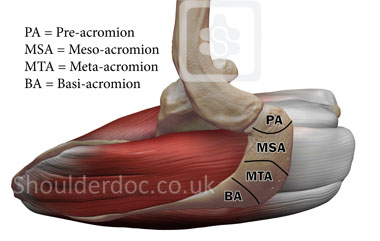Os Acromiale
Authors - Dipankar Bhattacharyya & Lennard Funk
The acromion is the most prominent bone on the top of your shoulder. You can feel it easily. The acromion developes as four separate parts during childhood. These have all joined together (fuse) by the age of 25 years in most people. However, in 8% of people one or more of the parts do not fuse.
The ‘parts’, known as ossification centres are: Preacromion (pa) Mesoacromion (msa) Metacromion (mta)and Basiacromion (ba).

Failure of fusion between msa and mta is most common but other combinations may be present so that there may be 7 possible types of Os acromion.
The free fragment is usually one-third of the length of the acromion and includes the acromioclavicular facet and attachments of the coraco-acromial ligaments.(JBJS-B-1993 75-4)
A strong association with rotator cuff tears has been reported but is usually a co-condition rather than a causative factor (Act Orth.2000 76-2).
Pain is due to:
- Impingement from the unfused fragment bending forward with contraction of the deltoid and ‘traping’ the rotator cuff..
- Concomitant rotator cuff tear.
- Motion at the unfused site leading to arthritic changes.
This can present exactly like subacromial impingement, with superadded point tenderness.
X-rays are necessary to diagnose the os-acromiale. The best view is the axillary view of the shoulder, although it can be seen on other x-ray views. It can also be seen on MR, ultrasound and CT scans.
Treatment :
Initially: Physiotherapy, anti-inflammatories and pain-killers
Injections: Depending on the site of pain - subacromial and directly into the unfused, arthritic site. Injections under ultrasound guidance are more accurate, if available.
Surgery
1. Fixation and Fusion of the unfused segments - Indicated for larger fragments, such as msa, mta and ba. (J Shoulder Elbow Surg 2004 13-4). This is usually done by an open procedure, but can be done arthroscopically.
2. Arthroscopic excision of the unfused fragment (Subacromial decompression) - Indicated for small pre-acromion (pa) only.
a. For more details on the surgery and rehabilitation click here


